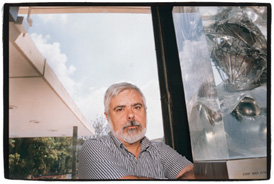It would not be off the mark to say that Prof. Haim Garty grew up side by side with the Weizmann Institute. Garty, who was born in 1948 in Bulgaria, immigrated to Israel with his family in 1950. They settled in the Institute's hometown, Rehovot.
Garty recalls standing on the road leading to the Institute waving a Belgian flag. He explains: "Rehovot elementary schoolchildren often acted as official welcomers, especially when a foreign dignitary came to call. As a child of Rehovot, he was a frequent Weizmann visitor -- whether on school outings or during social and cultural events held on Institute grounds.
"I regarded the Institute as a wondrous place. It had the aura of a scientific temple," says Garty. Having always been interested in science, joining the Institute was, for him, "the natural choice." While enrolled in the Rehovot High School -- later renamed after Amos de-Shalit, who had been the Weizmann Institute's Director General -- he chose the math-physics program as his major. After completing a bachelor's degree in chemistry at the Hebrew University of Jerusalem, he went on to complete both his master's and Ph.D. degrees at the Institute, under the tutelage of Prof. Roy Caplan of the Membrane Research Department.
Today, Garty's research focuses on the passage of ions through biological membranes via protein structures called "ionic channels." Garty explains: "My attraction to this field of research was rather fortuitous. After completing my doctorate in biophysics, I looked for a research area that was related to health problems and could contribute to the understanding of a physiological mechanism."
The scientific issues his research group addresses are related to salt absorption in the kidney and blood pressure control. "Our work is not directly aimed at searching for actual medicines or immediate cures," he says. "We focus on determining and understanding the fundamental mechanisms. This is the first and basic step that will eventually lead, we hope, to new, more efficient drugs and better medical treatments."
He sees a growing investment in state-of-the-art equipment in the Institute. "Today, we offer our young people better facilities and more access to frontline technology. Still, we also ask far more of them than before, even more than was asked of us."
Garty's long-standing relationship with the Institute gives him a particular vantage point when looking at changes that have taken place. "It's clear that the Institute's reputation in the scientific world has been maintained over the years, but it's also obvious that it is now more beautiful as well as more impressive."
